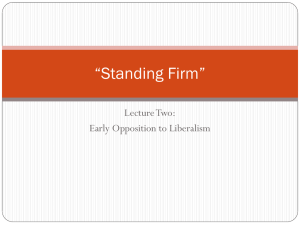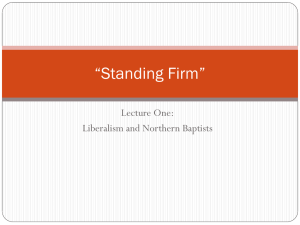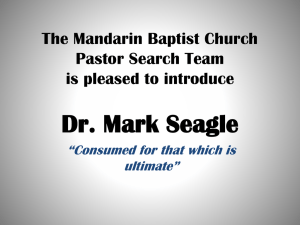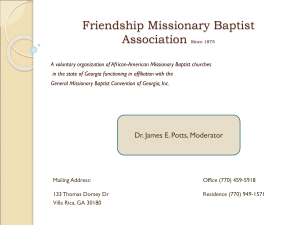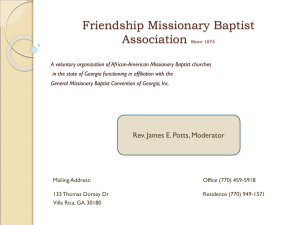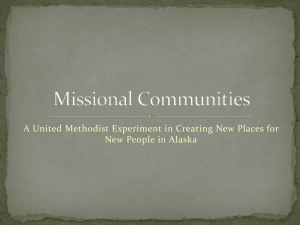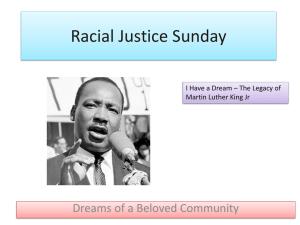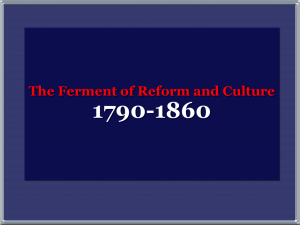Baptist Women
advertisement
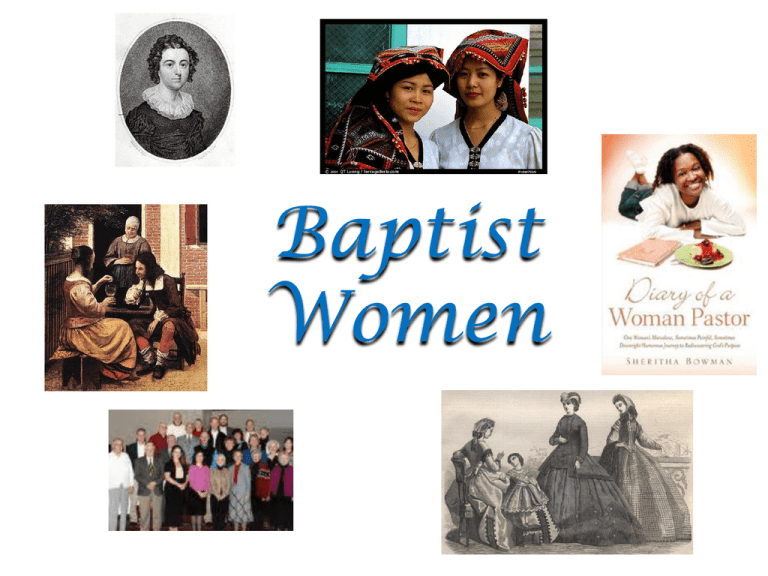
Baptist Women Baptist Women I. Introduction A. Content of Lecture B. Distinction between Deacon and Deaconess Charles Deweese Distinction between Deacon and Deaconess Baptists have usually made a clear distinction between them Deaconesses were usually not ordained, they often met separately from deacons, and were seen in a subsidiary role as assistances to deacons. But, some Baptists did ordain deaconesses and made no distinction between them and deacons. Indeed, the term “deaconess” has been used to refer to a woman deacon. Baptist Women II. An Historical Overview A. England B. America C. The 20th and 21st Centuries John Smyth 1605 A Pattern of True Prayer “Deacons are 1. Men 2. Women deacons or widows . . . . Women deacons or widows are of 60 years of age, qualified according to the Apostles rule 1 Tim. 5.9, relieving the bodily infirmities of the Saints with cheerfulness.” 1607 Principles and Inferences Concerning the Visible Church “Women are not permitted to speak in the church in time of prophecy.” Thomas Helwys 1611 Confession of Faith Article 20 “That the officers of every Church or congregation are either elders, who by their office do especially feed the flock concerning their souls, or deacons, men, and women who by their office relieve the necessities of the poor and impotent brethren concerning their bodies.” Thomas Edwards Among the Baptists “there are also some women preachers in our times who keep constant lectures, preaching weekly to many men and women.” Two Significant Points 1. Baptist women apparently held the majority in many churches. 2. Baptist women suffered persecution in the same way as did men. They were “fined, whipped, and jailed along with their menfolk.” South Wales Baptist Association 1654 “For the assistance of deacons there are widows, of whom, see 1 Tim. 5.16, who are likewise to serve the church, Ro. 16.1 most probably in looking to the poor and sick.” Records of the Broadmead Baptist Church Bristol, England 1679 On the Duties of Widows or Deaconesses 1. 2. 3. 4. 5. “Their work was further declared to them in these particulars: To visit the Sick, to have their Eye and Ear open to hearken and enquire who is sick and to visit the sick sisters in a special manner, to see what they Need Because it may not be so proper for men in several cases. To visit not only sick Sisters, but sick Brethren also; and therefore some conceive may be the Reason why they must be 60 years of age, that none occasion may be given; and as 1 Tim. 5.14. Not only to take care of their sick bodies, of the Brethren and Sisters, But that their wants may be supplied; and therefore to make reports back of their condition, to the Elders and Deacons of the Congregation. It is their duty also to speak a word to their souls, as occasion requires, for support or consolation, to build them up in a spiritual lively faith in Jesus Christ; for as some observe, there is not an office of Christ in his Church but it is dipped in the blood of our Lord Jesus. Some think it is their duty to Attend the sick; and if so, then they are to be maintained by the Church.” H. Leon McBeth “The records do not show any uniformity of duties for those churches that did accept women deacons and preachers. However, we gather that the office of deaconess was primarily a welfare office.” H. Leon McBeth “The role of Baptist women tended to diminish in England as the years passed. Women were quite active in the 1600’s, still active in the 1700’s, but less so by the 1800’s. By the mid-1800’s some churches had abolished the office of deaconess, and some even questioned the right of women to vote in church conferences, much less to speak out.” The Order of Baptist Deaconesses The Baptist Deaconess Home and Mission Opened 1890, London Gwenyth Hubble “The existence of an order of deaconesses has been, for us as a denomination, an escape route by which we have avoided facing the real issue of women in pastoral ministry, and we have been content, because of the shortage of male ministers, to let women do the work of the pastoral ministry and call by another name.” She concluded, “It is obvious that a church will be prepared to have a deaconess when it cannot afford to have a minister because she is cheaper.” Bill J. Leonard “Women were at the center of frontier Baptist church life.” In the early revivals, “women were allowed to ‘prophecy’ (preach) even to mixed audiences. With time, however, the practice was discouraged. The sphere within which women could serve was narrowed: they “could prepare communion but not serve it, feed the preacher but not preach themselves.” The Philadelphia Baptist Association “There must be times and ways in and by which women as members of the body may discharge their conscience and duty towards God and men.” The Bible “’excludes all women whomsoever from all degrees of teaching, ruling, governing, dictating, and leading in the church of God.’” Morgan Edwards “The Scripture forbids women to speak, ask questions, teach, dispute, rule, or vote in church.” Baptists in the American South Separate Baptists Roots lay in Calvinistic Baptists who became highly evangelical in the Great Awakening revivals Spread in rural areas (more a frontier setting where women had had a stronger role in Baptist churches) Margaret Clay and Martha Stearns Marshall were noted preachers Regular Baptists Roots lay in the staunchly Calvinistic Particular Baptists Found in urban areas Opposed to deaconesses, women speaking in church, women preaching H. Leon McBeth “The United Baptists (and later the Southern Baptists) largely accepted the Regulars’ concept of ministry and doctrine. . . . The Separate tradition of the leadership role of women . . . largely disappeared.” Freewill Baptists 1746 licensed a woman to preach 1791 ordained Mary Savage who was “the first name in the records as a female laborer in the gospel.” Examples of Ordinations in the Nineteenth Century 1876 M.A. Brennan, Freewill Baptist 1887 and 1889 two other Freewill Baptists 1882 May C. Jones, Northern Baptist Convention 1885 Experience Fitz Randolph Burdick, Seventh Day Baptist H. Leon McBeth “The evidence suggests that in the nineteenth century many Southern Baptists approved deaconesses and regarded the offices as biblical. Moreover, at least some churches acted upon these views and regularly set aside deaconesses as well as deacons. Probably Southern Baptist churches have never been without deaconesses.” Lottie Moon “There is a latent power in our churches which, following the wise example of other denominations, we should seek at once to develop.” The Baptist Deaconess Home 1884 New York City Sarah Frances Anders “Many state Baptist newspapers will not publish information about the ordination of women because they want to avoid having their editorial staff criticized” Examples from the Southern Baptist Convention Addie Davis ordained in 1964, the first ordained Southern Baptist woman (moved to the American Baptist Convention to pastor) Druecillar Fordham (ordained by the American Baptist Convention), in 1965 became the first woman pastor of a Southern Baptist church and the first African-American ordained woman to serve in the SBC 1964 - 1997 Sarah Frances Anders documented 1,225 ordinations of Southern Baptist women—an average of 37 per year. Leon McBeth said that between 1964 and 1978 perhaps fifty or more women were ordained in SBC churches, a number of them for the chaplaincy. 1984 SBC Resolution “On Ordination and the Role of Women in Ministry” Paul “excluded women from pastoral leadership (1 Tim. 2:12) to preserve a submission God requires because the man was first in creation and the woman was first in the Edenic fall (1 Tim. 2:13ff).” The Baptist Faith and Message 2000 Article on the Church “While both men and women are gifted for service in the church, the office of pastor is limited to men as qualified by Scripture.” Anna Marie Feltner “When I entered the education ministry it was unheard of for women to be ordained . . . I will not ask for ordination. My people know I am their minister.” American Baptist Convention Resolution on Women and Ordination 1965 “We believe there should be no differential treatment of men and women in the church, family, or society and that there should be equal opportunity for full participation in the work of our God.” American Baptist Convention 2003 410 women serving as ABC pastors, 9% of all ABC pastors said to be an increase of 13 over 2004 American Baptist Convention 2005 American Baptist Women in Ministry reported 403 women serving as pastors or co-pastors of ABC churches African-American Baptist Churches 57% of Progressive National Baptist pastors and 74% of Nation Baptist Convention USA opposed ordination of women African-American Baptist Churches The 1997 reports of the National Baptist Convention of America and the National Baptist Convention USA said none of their churches had women pastors Freewill Baptists ordaining women as early as 1876 between 1780 and 1920 , 70 women pastored churches in the 1950s begin excluding women from leadership positions in 2005 only one conference (out of seven) reported any ordained women serving in its churches—another one reported a restructuring of its licensing process hoping all candidates regardless of gender would receive serious consideration Seventh Day Baptists first woman ordained in 1885 since that ordination at least 15 other women have been ordained in 2005 , 4 out of 127 pastors were women, 3 in full-time positions and 1 as an associate pasor Other Baptists 2005 Alliance of Baptists had 118 churches with 26 women as pastor or co-pastor Cooperative Baptist Fellowship had 1,854 churches with at least 5.5% served by a women pastor The Baptist General Association of Virginia had 1,411 churches with 16 women pastors or copastors The Baptist General Convention of Texas had 5,900 churches with 11 women pastors or co-pastors Pamela R. Durso “Given the number of Baptist churches in the nation . . . less than 5 percent of all Baptist churches in the United States had a women serving as pastor” [in 2005]. Since 1964 Baptist churches have ordained an estimated 1,600 women. Durso estimates this would double if we included American Baptists, Free Will Baptists, national Baptists, Progressive National Baptists and Seventh Day Baptists. The majority of these women worked as chaplains or served on a church staff working with children or youth or serving as an associate pastor. Baptist Women in Ministry 2005 Report “In the early twentieth century Baptist churches began to employ women (without ordination) to direct specific ministries of the church.” (my emphasis) Southern Baptist Convention 2001 motion to stop the ordination of women as chaplains 2002 the North American Mission Board ceased endorsing ordained women or women who asked to be ordained as a chaplain H. Leon McBeth 1973 only 200 to 300 SBC churches had women deacons Charles Deweese In Women Deacons and Deaconesses he listed 292 Baptist churches where a women had been chair of deacons—most affiliated with the CBF Deweese said, “Since the number of churches with women deacons that have not yet had a female chair is much larger than the number that have, it is extremely likely that thousands of Baptist churches nationwide and worldwide have women deacons.” Baptists in Other Countries Marita Munro, Australia, 1978—seven more ordained between 1991and 1997 Angelina Belluga Buensuceso, Convention of Philippine Baptist Churches, 1980 Cuba, 1992, three women ordained—early 21st century there were 20 ordained men pastors and 13 women Silvia de Silva Nogueira, Brazil, 1998 Rebeca Montemayor Lopez, Mexico, 2000 Carolyn DeArmond Blevins “Reflecting on Baptists and women's issues in the twentieth century, it seems to me that there was one issue that dominated woman's relationship with Baptists: who controls the voice of women? One statement sums up woman's story in twentieth century Baptist life: Baptist women, black and white, in the north and in the south, spent the century trying to get a voice in the denominations they served. Recall some of the issues Baptist women faced in the last century: Can women speak in mixed audiences? Can women vote in the nation, in the convention, n the church? Will women be elected to denominational boards? And if they are, will they be elected at the same rate as men? Can women be admitted to all educational opportunities? Will women be hired into any vocation to which they are called? Can women be ordained? Will churches call women as senior pastors?” “From the early 1900s to the late 1990s, too many Baptists preferred women with silent voices--women who would unquestionably follow the authority of men,” Li Li “The rise of educational missions offered Southern Baptist women a great opportunity in China at the turn of the century. Historically speaking, the most common public profession for women was to become teachers especially at the primary and secondary levels. By participating in the Southern Baptist educational effort in China, women found an effective way to change their role in the foreign missions.” “During the late nineteenth century and the early twentieth century, there was a revolution among the Southern Baptist women in their attitude toward foreign missions. Independence became the key word.” Baptist Women in Ministry Baptist Women in Ministry Purpose Statement: The organization will “provide support for the women whose call from God defines here vocation as that of minister . . . And to encourage and affirm her call to be a servant of God.” Mission Statement: “To be a catalyst in Baptist life, drawing together women and men in partnership with God, to illuminate, and advocate, and nurture the gifts and graces of women.” Baptist Women IV.Some Concluding Thoughts A. Pamela R. Durso B. Charles Deweese C. Charles Deweese D. Carolyn DeArmond Blevins E. An Exception to the Rule Pamela R. Durso “In truth, other denominations have benefitted from the Baptist opposition to women ministers. Scores of Baptist women have fled their childhood denomination and moved into Methodist, Presbyterian, Disciples of Christ, and United Church of Christ circles. Yet, many Baptist women who have been called to and gifted for ministry have remained Baptist, and their steadfastness has brought renewal and change to the churches to which they belong.” Charles Deweese “What issues are at stake in this discussion relating to women deacons? A partial list would include at least the following: the power of God to call women into whatever ministry he chooses; the focus given or not given to the life, spirit, and teachings of Christ in assessing the matter; literal views of scripture compared to more contextual understandings; misuses of the writings of the apostle Paul relating to women; the place of women in the ministry and service of the church; the implications of growing patterns of excessive pastoral authority in Baptist life; increasing concerns about women’s subordination and submissiveness in denominational confessions of faith, resolutions, theological education, missions programming, and curriculum literature; diverse attitudes regarding the biblical basis and meaning of ordination; misuses of the autonomy of the local church against women’s leadership and service; and theological influences that affect Baptist’ attitudes toward women” Charles Deweese “Finally, as Donald F. Thomas put it in his 1969 Judson Press book The Deacon in a changing Church, ‘It may be that the most important question is not whether women should hold positions in the church but whether the modern church can fulfill its ministry without them.’” Carolyn DeArmond Blevins “We Baptists tout our doctrines of freedom while we muzzle our female voices. It is a very confusing message.” An Exception to the Rule Jana Mayfield Mullen “Rebecca Anna Phillips: Question of Authority and Gender among Primitive Baptists” Baptist History and Heritage Winter 2006: 67-76

